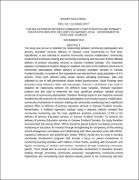| dc.description.abstract | ABSTRACT
The study was set out to establish the relationship between community participation and primary education services delivery in Garowe Local Government in Punt land. Specifically, it was intended to examine community resource mobilization, community involvement in decision making and community monitoring and how each of these affected delivery of primary education services in Garowe Puntland Somalia. The researcher adopted a correlational research design to establish how each of the different constructs of community participation affects delivery of primary education services in Garowe Puntland Somalia. A sample of 191 respondents was selected from study population of 374 persons. These were selected using simple random sampling techniques. Data was collected by use of self-administered closed ended questionnaires. Study findings were presented using frequency tables and percentages. Pearson’s correlations were used to establish the relationship between the different study variables. Multiple regression analysis was also used to determine the most significant predictor variable among constructs of community participation. Research findings based on the responses received revealed that all constructs of community participation (community resource mobilization, community involvement in decision making and community monitoring) had a significant positive effect on delivery of primary education services in Garowe Puntland Somalia. Nevertheless, a multiple regression analysis using a stepwise method revealed that community monitoring was the most significant predictor contribution 12.9% to the delivery of primary Education services in Garowe Puntland Somalia. To enhance the delivery of primary Education services in Garowe Puntland Somalia, the study therefore recommended that among others, efforts should be geared towards increasing community monitoring in education, for instance through strengthening the competency of the existing school management committees and collaborating with other education actors like NGOs, regulatory institutions and philanthropic bodies. Efforts should also be made to develop community involvement programs that include a focus on parent involvement in conducting learning activities with children in their homes, assisting with homework, and regular monitoring of students and teachers’ attendance through conducting community patrols. There should also be increase in community involvement in education decision making through promoting community awareness, strengthening community-school relationship and surrendering local decision-making power to the community and also
increase community resource mobilization through communicating to the community that their support makes a great deal of difference in educational success of the children. | en_US |

